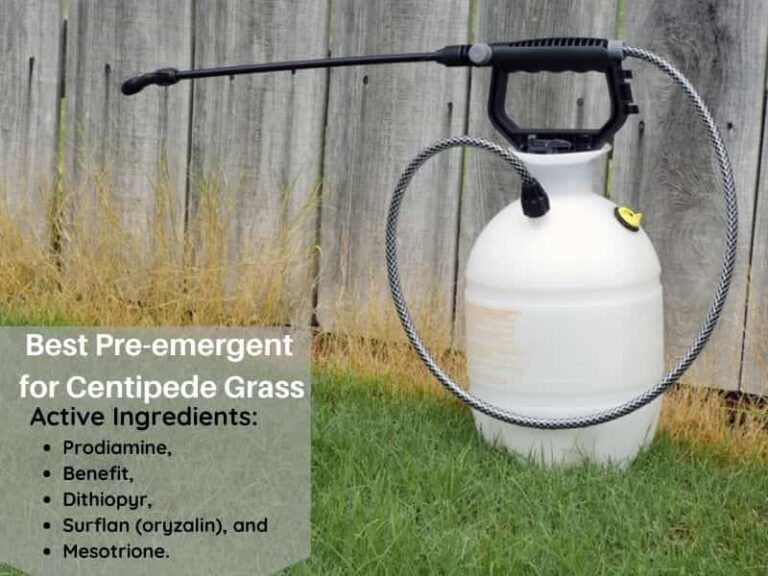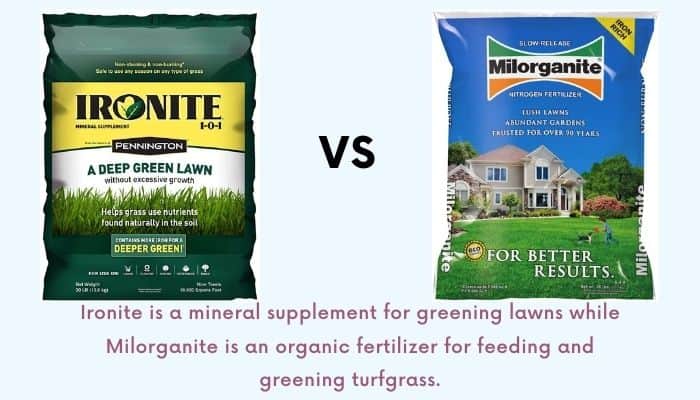Spike VS Plug Aerator (Which is Best for You?)
Your lawn requires regular aeration to maintain lush and vigorous grass. Proper aeration increases water and nutrient absorption by roots. Spike aerators or Plug aerators are the most appropriate tools to aerate the soil. They tackle different levels of soil compaction.
A spike aerator is best for use on loose soil that needs more aeration or when you have small areas where manual labor is appropriate. However, a plug aerator works better on deeply compacted soil on a huge tract of land. A spike aerator has more options, manual towed and electric aerators, to make your work faster and easier than plug aerators.
I’ve dug up insightful information to help you pick a better aerator when preparing your lawn.
Table of Contents
Does Spike aeration work?
Spike aeration works best in areas with loose soils. Sandy soil areas are great for spike aeration, with better results when aerating small lawns. Spike aeration works in lawn fields with mild thatch problems.
It is the best solution when you want a minimally invasive method. Spike aeration is considered cheaper than Plug aeration. It has been approximated at $ 65-120 per 10000 square feet. Spike aeration is cheaper when you do it yourself, while equipment costs approximately $20-70.
The spike aeration usually pokes holes in the ground without removing or turning the soil. The aerator squeezes the soil to the sides of the spikes. The holes made are approximately 2 inches apart and 1-2.5 inches deep into the soil. Spike aeration can be done any time of the year. Unlike plug aeration, it doesn’t put a lot of stress on the grass.
Unfortunately, spike aeration will not solve long-term soil compaction. After a long period of short-term fixes, you have to break out the plug aerators to aerate bigger chunks of heavily compacted soil.
Is a plug aerator worth it?
Plug aeration has the most comprehensive benefits for your lawn. It is also arguably the most expensive method than Spike Aeration or Liquid aeration. This is because plug aerators are complex equipment that need higher investment than Spike aerators.
But how does the core aerator work?
Plug Aerators also referred to as core aerators, work by plugging hollow tines into the soil that remove the plugs of soil from the lawn. The plug aerator removes approximately 2-3 inches deep, 0.5-0.75 inches in diameter, and 2-3 inches apart of soil.
With this method, the aerator will break, remove, and redistribute the compacted soil. The size of the wads of soil removed will depend on the size of the machine used. The result will be scattered soil on the lawn and holes left in the ground.
There are several types of plug aerators available for sale or rent. For example;
- Manual core aerators– Using this equipment is tedious. You push this aerator deep into the grass to remove the soil cores. It’s best for use when aerating lawns by hand.
- Tow behind aerators-These are aerators that can be towed behind a lawn tractor or a mower.
Note: There are also gas-powered core aerators and electric aerators
Hiring a professional to plug aerate your lawn is better than buying your own machine. A plug aerator will also require a tractor which is an additional expense. A professional can also advise on the problematic areas on your lawn that need fixing. According to Home Advisor, Plug Aeration costs approximately $120-175 per 10000 square feet. This amount is dependent on the location, prep work, and type of soil.
When plugging, make several passes in different directions for the best results and concentrate on the problematic areas like where there’s compaction. You can leave the soil cores on the ground to disintegrate as organic material.
Spike vs. plug aerator; which is better?
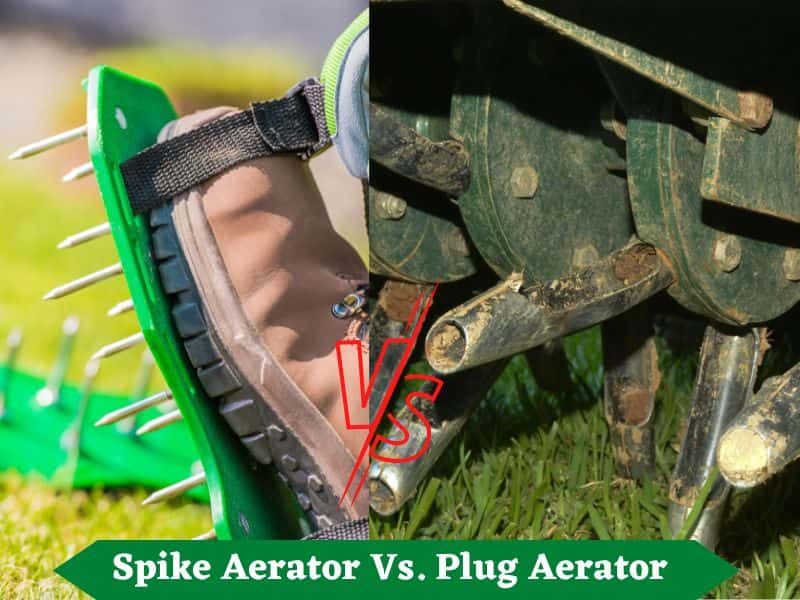
Deciding between a spike and a plug aerator depends on a few factors.
- The size of the lawn you are aerating,
- Your budget,
- Your location’s soil type.
Overall, you are better off with a plug aerator because you can diversify its use. Unlike a spike aerator which limits you to manual labor and a small lawn, plug aerators can be used on small fields and large tracts. While plug aerators may cost more initially, they are better since you finish your work faster. Its outcome lasts for a longer time. Furthermore, you could always rent out the equipment to recoup some of that buying price.
Spike aerators are manual tools used to make the soil less compact. They often come in a barrel shape with sharp tines. The labor-intensive tools make holes in compacted soils without lifting sods or clumps from the ground.
There are different types of Spike aerators. Forks also qualify as spike aerators since they work the same way.
- Pitchfork or spading fork: To aerate your lawn push the fork back and forth about 4 inches deep into the ground. This equipment is cheap and ideal for small areas.
- Spiked aeration shoes: These shoes have spikes that are about 2 inches long and ⅛ inch thick. They allow you to aerate your lawn as you walk. The spikes in the shoes cannot go deep. Some come as attachments that can be tied to your normal shoes or boots. This method will be useful only for light maintenance.
- Hand manual aerator: These take longer and are suited for smaller lawns.
- Rolling push spike aerators: These aerators have a rotating wheel or drum. These aerators are often pushed and can cover a larger area than hand or foot aerators.
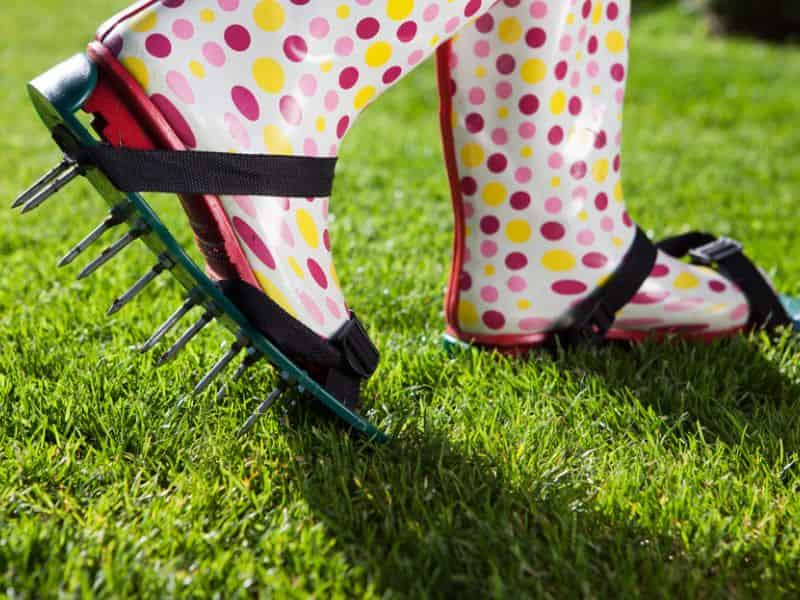
On the other hand, plug aerators come in three levels:
- Manual plug aerators
- Towed plug aerators
- Electric plug aerators
Plug aerators dig up compacted soils and grass plugs. They are the best solution if you want loose soils for a longer period and how often to aerate your lawn, especially over a large field.
| Spike Aerators | Plug (Core) Aerators |
| They create little holes in the ground by squeezing the soil to the sides of the spikes. | They create hollow tines and remove plugs from the soil. |
| Spike Aerators reduce compaction in the short run but increase compaction in the long run. They solve minor compaction problems. | They reduce compaction in the long run. When the soil is removed, holes are created that reduce compaction. Plug aeration is effective for severely compacted lawns. |
| Spike aerators are more affordable and more widely available. | Plug aerators cost more as a first-time expense. Still, you can rent a plug aerator. |
| Spike aerators are manually operated. | There are manual plug aerators, and there are electric-powered plug aerators. |
| Best suited for small lawns with light soil. | Best suited for big lawns with hard soils. |
Pros of spike aeration
- It is less expensive.
- It is less messy because it is less disruptive.
- It works better for small home lawns.
Cons of spike aeration
- It is less effective because it does not aerate thoroughly. It’s a short-term solution.
- Spike aerators are labor-intensive.
- It is time-consuming. It takes longer to aerate a large portion with spike aerators than with a core aerator.
Pros of plug aeration
- Plug aerators are more disruptive and have better long-term outcomes on your lawn.
- Electric plug aeration is less labor-intensive.
- It has a quicker turnaround time.
- It works on large tracts of land.
Cons of plug aeration
- Plug aeration digs up soil plugs, leaving the ground messy and unattractive for a while.
- Use of plug aeration too often can stress your lawn.
- Sometimes the hollow tines get filled with soil and have to be emptied before plugging again. They also get blunt and have to be sharpened.
What type of aerator is better: spike or plug aerator?
The best method of aeration depends on the condition of your lawn. Some lawns require spike aeration, while others require plug aerators.
Spike aeration is preferable if the lawn is lightly used and needs a quick fix, while core aeration is used for severe compaction. However, plug aeration is a necessary yearly practice to achieve and yield a healthier lawn than spike aeration.
Like sandy soils with mild compaction, light soils are great for spike aerators, while heavily compacted clay soils will benefit from plug aeration.
It has become more common lately to combine both the spike and plug aeration for better results and healthy lawns.
Tips for aerating your lawn
Follow the instructions given by the manufacturer or rental company. You also can hire professional gardeners to aerate your lawn.
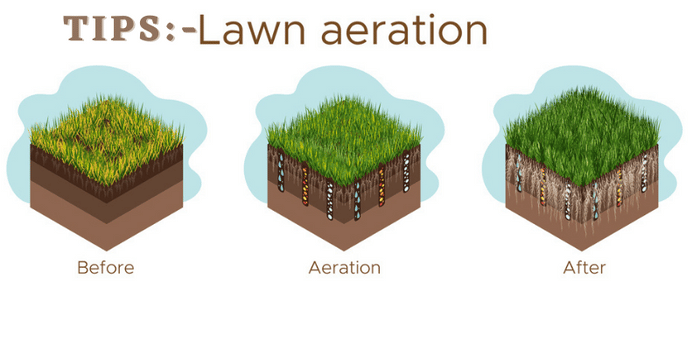
Here are some precautions to consider when aerating your lawn.
- Mow the grass before aerating.
- You should avoid aerating grass that has not been completely established. This also depends on the type of grass. Wait around two years for grass that had been sodded for the roots to establish.
- Do not aerate when the soil is completely dry. Also, avoid wet soil that will cling to the tines.
- After aerating, continue the common basic lawn maintenance practices like mowing, fertilizing, and irrigating.
- Do not apply pre-emergent herbicides before aerating your lawn. Aeration will disturb the herbicides before it functions.
References
- UMass Extension|Center For Agriculture; Compaction Management with Aeration
- Clemson Cooperative Extension; Aerating Lawns | Home & Garden Information Center

